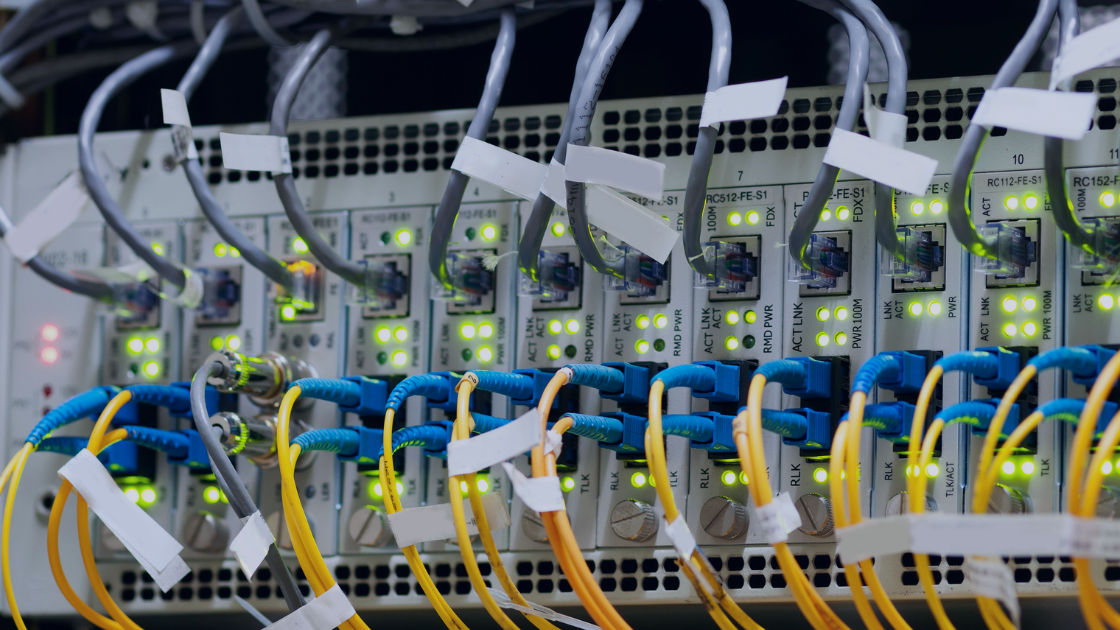Modern businesses, regardless of their types, depend on the extensive use of digital tools and infrastructure. In 2022, you would not see an employee without a laptop or a smart device in any given organisation. For the smooth use of these digital tools, having a communication network in place is a must.
Indeed, contemporary facilities, from manufacturing plants to skyscrapers, rely on extensive communication networks to connect people and devices to the internet. As you can imagine, the energy consumption of these 24-hour networks is high: In 2021, the global electricity consumption of data centres amounted to 220-320 TWh, or about 0.9-1.3% of the global final electricity demand.
In this article, we give you some tips to better manage the energy consumption of your communication networks. Whether your company is large or small, you will have to manage data that is often stored in a dedicated room. In this post, we will use data centres to give you concrete examples. Indeed, although these centres are only dedicated to the management and protection of data, you can draw inspiration from their management to reduce the energy consumption of your network devices. Keep reading!
Energy Consumption of Networks
The demand for higher network speeds and greater bandwidth is increasing as the data economy grows. Communication networks required to meet this demand consume a greater amount of energy than existing network components. This shift in the nature of communication networks has led to an increase in the carbon footprint of facilities and data centres themselves. “It is no secret that data centres are energy-thirsty, and even with revolutionary renewable energy sources, radical changes will be needed in the coming years to continue to support hyperscalers”, highlighted Dansk Energi.
Data centres and data networks are estimated to account for almost 1.5% of energy-related Green House Gas (GHG) emissions worldwide and have direct and indirect effects on energy use and emissions. According to a study led by the International Telecommunication Union, in 2020, data centres and data networks already accounted for 300 million tonnes of CO2 equivalent (equals 0.6% of total GHG emissions). Yet most facility managers run network devices 24 hours a day, 7 days a week…
These emissions, which are expected to increase, must be divided by two to meet the Net Zero by 2030 Scenario. Indeed, the telecoms industry is not exempt from energy reforms put in place by various governments and the current shift to 5G is a chance to leave a cleaner and greener footprint in the sector. However, there are only a few global policies and regulations aimed primarily at reducing the energy consumption and carbon footprint of data centres and networks, despite the fact that electricity decarbonisation policies play a key role in reducing emissions in today’s world.
Although the high energy consumption of the sector has been demonstrated, energy professionals often tend to overlook its effect. Therefore, to have a positive impact on climate change mitigation efforts, monitoring and reducing the energy consumption of communication networks is essential and can no longer be disregarded.
Energy Savings Measures
Taking energy savings measures is the first step toward energy efficiency and the reduction of the carbon footprint of your facility. Did you know that with proper planning and implementation, the energy consumption of your devices can be easily controlled and thus reduced?
The following sections present some of the ways you can adopt to lower the energy consumption of your network infrastructure.
Devices contributing to Energy Consumption
Here is a list of the many devices a network infrastructure uses to power the network:
- Hubs
- Switches
- Network interface card (NIC)
- Modems
- Firewalls
- WiFi routers
- Wireless Access Points (WAP)
- Ethernet cables
- Fibre optic cables
- Structured cabling
- Low voltage cables
- Power supply units (PSU), among others.
It is no surprise that all these listed devices contribute to the energy consumption of your facility. Therefore, to save energy, it is essential to consider the power rating of each device you wish to install in your network. You should always use energy-saving devices and cabling solutions in order to lower the energy consumption of your plant and the same applies if you have an existing network: check the power rating of each device and cable separately. Make sure you take into account the power consumption of the equipment before you install it. However, if your device is already in place, consider the use of an energy-efficient one when replacing it.
Always examine the Energy Star rating of devices to see if they are suitable for your needs and requirements. In most cases, Energy Star ratings compromise performance for the sake of energy savings, but you should keep in mind to balance the performance you need with the Energy Star classification.
Cause of high Energy Consumption: Heat
In data centres, the air conditioning system (HVAC) is responsible for most of the energy consumption (38%). Networking devices generate heat while operating, which can highly hinder their performance, thus, saving energy while keeping equipment at an optimal and constant temperature is one of the biggest challenges facing data centres. Indeed, most core network equipment is housed in air-conditioned rooms, where AC is running at full speed to cool down appliances, which leads to the increased energy consumption of the network infrastructure.
But…were you aware that it was possible to harness waste heat? Many data centres have realised the considerable potential to use waste heat to decarbonise their operations. Indeed, waste heat from the data centres could be used to heat nearby commercial/residential buildings or to supply industrial heat users, thus reducing energy consumption from other sources.
Cause of high Energy Consumption: Idling
In most corporate networks, due to high traffic, access points idle for hours, consequently, power consumption is high even during these periods, resulting in a waste of energy. Many network devices come with sleep and performance states to manage power usage based on network traffic. Some devices simply turn off certain components when traffic is low whereas others control power usage by adjusting performance.
You need to activate these settings to benefit from good energy management of the devices. As mentioned above, first choose devices with excellent power management options. Second, use the power management option optimally: the choice of network protocols also has an impact on the power management of devices, so go for the one that suits your needs and consumes the least energy.
“Optimising energy consumption in the ICT industry means reducing energy consumption per bit so that the growth in carbon emissions is slower than the growth in traffic”.
Cause of high Energy Consumption: Rate Adaptation
Rate adaptation is the criterion that determines the number of packets of information that pass through the network device. In other words, it is a good indicator of the device’s performance. To illustrate, in wireless networks, the signal can be strong or weak.
Network installers can adopt different rate adaptation algorithms in the network infrastructure and its components, which can be used to automatically adjust performance based on the real-time needs of the network.
You should use the rate adaptation algorithms that meet your needs without compromising your performance as there is a wide range available but you can also choose to build a new algorithm that is tailor-made to your own requirements.
Reducing High Energy Consumption: Power down
Most buildings do not operate 24 hours a day, as they are usually closed at night. However, you might be surprised to learn that the facility management does not normally switch off the network devices during this period, which wastes a lot of energy. The same applies to weekends when offices and other buildings are not in use.
Did you know that some simple things, such as switching off many of your network devices during this period can reduce your energy bill?
Remember that not all network devices are equal: not all devices in your network infrastructure can be switched off when not in use. For example, you can turn off the building’s WiFi routers when no one is there, but on the other hand, you cannot switch off the servers that process data and connect to the cloud infrastructure. Take proactive steps and determine for yourself which devices can be turned off without consequences.
Reducing High Energy Consumption: Monitoring
Regular monitoring of energy consumption is important for optimum energy management. Let us explain: Suppose you have the most energy-efficient devices for your networks in the ideal configuration for low power consumption. Yet one device fails, resulting in increased power consumption without any performance issues. You would only be able to find it out if you have monitored the energy efficiency of your network infrastructure.
Therefore, you need to use the right tools and software to monitor the power consumption of devices. This way, you will be able to identify any anomalies in energy consumption. You will then have to investigate these discrepancies to determine the root cause of the problem in order to solve it. Monitoring is a crucial step that cannot be left out of the energy efficiency improvement process.
Toward greener Networks
Energy efficiency is a common topic due to the looming threat of climate change. Unfortunately, as we mentioned previously, the energy consumption of communication networks is often not taken into account, even though this article demonstrated that they contribute significantly to the carbon footprint of commercial facilities. By using efficient devices, implementing intelligent design and solutions, and monitoring energy, the impact of communication networks on energy consumption can be minimised.
As a facility manager, you should take this issue seriously and put some of the above-mentioned recommendations in place not only to reduce the energy consumption of your building but also to lower your energy-related costs.
On this note, if you want a concrete example of how Telcos can tackle energy efficiency challenges whilst satisfying their customers, discover Ooredoo’s success story here:
Editor’s note

Note that some changes have been made to reflect Dexma’s style and tone of voice.
Why implement an EMS?
Implementing an Energy Management System (EMS) such as the Dexma Platform, based on AI, will help you compare your energy consumption with that of similar buildings. It will also make recommendations for savings where there is the greatest potential. In this way, you will be able to assess your situation with all the information and decide what actions to take.
Our intelligent solution Dexma Analyse is based on artificial intelligence and will allow you to go one step further by monitoring and controlling your energy consumption on a regular basis, 24 hours a day. This way you can evaluate if savings targets are reached. On the other hand, Dexma Optimise performs automatic analysis and anomaly detection so that you can adapt your energy consumption and maximise it. The more data it processes, the more intelligent it gets as it learns about your consumption habits, schedules, and consumption on weekdays and holidays, among other things.
Don’t hesitate to get in touch with our Energy Experts to discuss how implementing an EMS can benefit your company!




